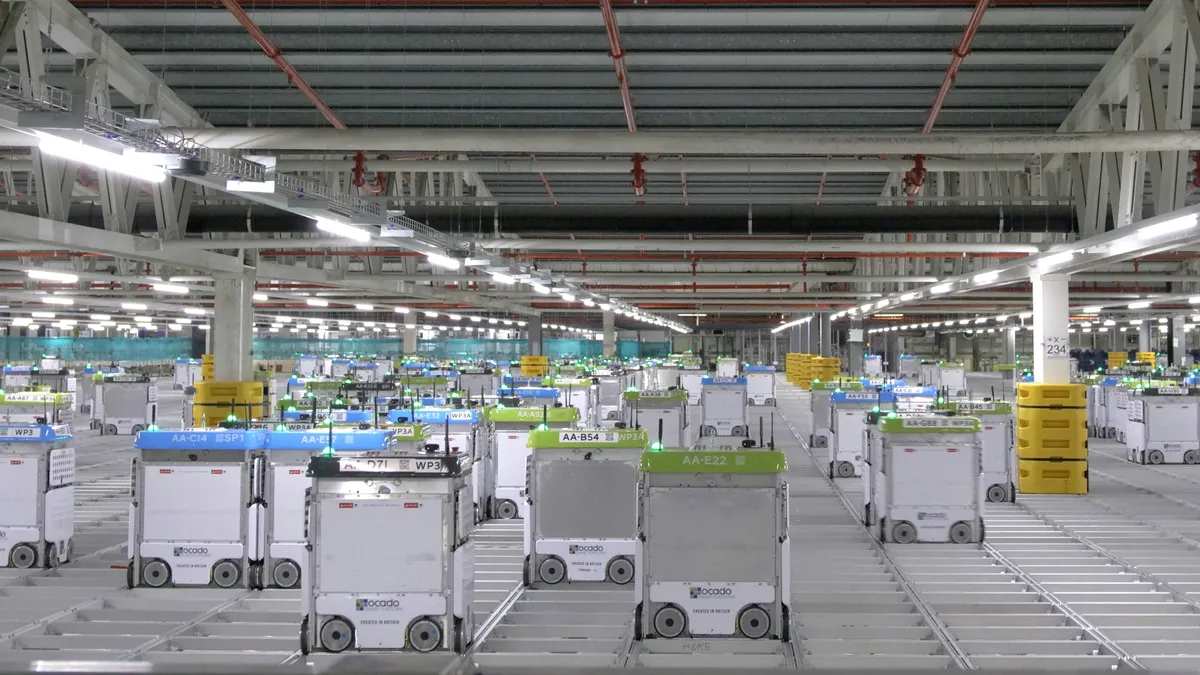UPDATE: Sept. 28, 2020: Kroger and Ocado announced Monday that the customer fulfillment center (CFC) in the Great Lakes region will be located in Romulus, Michigan.
The new 135,000-square-foot CFC facility will create 250 jobs and is expected to be fully operational in 18 months after the site breaks ground at 15675 Wahrman Road. Kroger is investing $95 million in the center in a move to expand its grocery delivery service in southeast Michigan.
Dive Brief:
- Kroger announced Friday that it will expand its partnership with Ocado to build three additional automated consumer fulfillment centers (CFCs), which the retailer said will improve its ability to quickly and efficiently fill online orders. The facilities will be located in the West, Pacific Northwest and Great Lakes regions of the U.S. The exact locations of the new centers will be announced soon.
- The West Coast CFC will be 300,000 square feet, the Pacific Northwest will be 250,000 square feet and the Great Lakes region center will measure 150,000 square feet. "The varying sizes demonstrate the flexibility of the Ocado fulfillment ecosystem to best serve the respective markets," the retailer announced.
- The new CFCs will altogether create 1,000 new jobs. Kroger has so far announced nine Ocado fulfillment center sites, with the first slated to open in Monroe, Ohio in early 2021.
Dive Insight:
At 300,000 square feet, Kroger's West Coast CFC is roughly the same size as other facilities it has announced in partnership with Ocado. However, the other two new locations are notably smaller — a development that underscores the versatility of the Ocado model to meet market conditions, according to retail research firm IGD.
"These sites will optimise the flexibility of the Ocado model, enabling Kroger to develop the appropriate ecommerce capacity in each location," wrote Stewart Samuel, program director with IGD, in a note Friday.
Although the companies haven't yet announced the exact locations for the three new facilities, IGD expects them to appear in areas where Kroger has a robust store presence. This includes the Seattle area, where it operates QFC and Fred Meyer stores, and Los Angeles, where its Ralphs and Food 4 Less banners do business. Overall, Kroger plans to build 20 CFCs in partnership with Ocado over the next several years, with each location taking between two and three years to build.
Soon after Kroger and Ocado broke ground on its first automated fulfillment center in June, analysts at equity research firm Jeffries said the partnership was a misstep and that each center, or “shed” as Kroger calls it, would take four years to turn a profit and return limited market share gains.
This was before grocery e-commerce sales boomed due to the unexpected coronavirus pandemic that forced many customers to shift to online shopping. Online grocery sales are expected to grow 40% in 2020 to $38 billion, according to a Coresight Research survey. Kroger is hoping this adoption rate sticks past the pandemic to prove its hefty bet on e-commerce was worth it.
To keep the momentum going in the near-term, Kroger continues to expand its e-commerce capacity. It has opened additional pickup and delivery slots from stores, added staffing and is waiving its $4.95 ClickList fee.
Kroger competitor Ahold Delhaize also ramped up its automation efforts during the coronavirus by recently outlining plans for two automated frozen warehouses on the East Coast.













